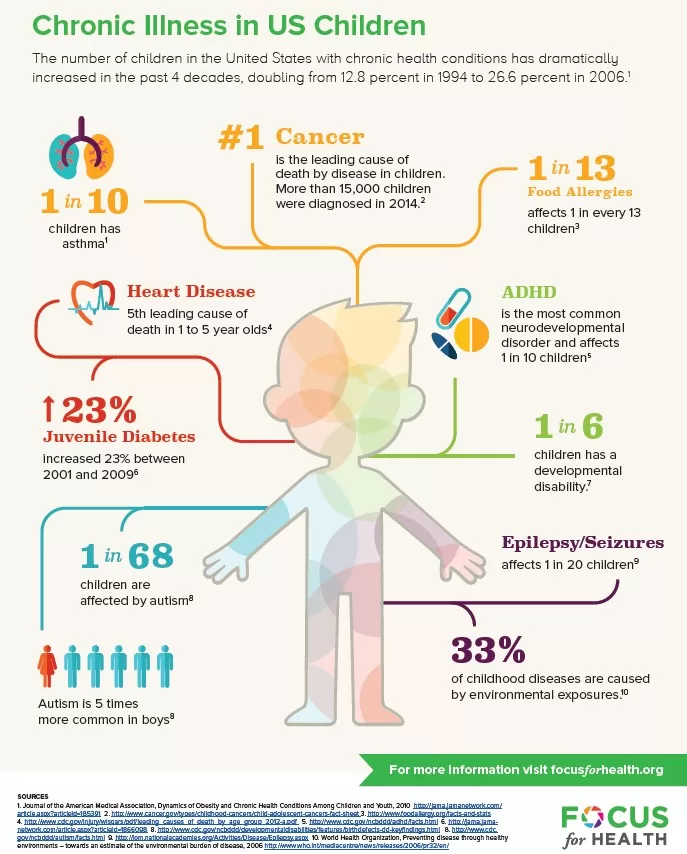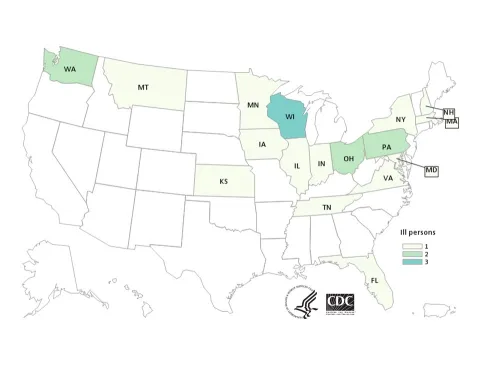Chronic diseases in US children have become an alarming concern, reflecting a significant rise in childhood diseases that jeopardize their health and future. Recent discussions surrounding the “Make Our Children Healthy Again” initiative highlight four potential factors contributing to this troubling trend: the consumption of ultra-processed foods, exposure to harmful environmental chemicals, a sedentary lifestyle, and chronic stress. These interconnected issues point towards a need for strategic interventions to ensure the well-being of the next generation. As studies continue to unveil the impact of these elements, families and policymakers alike are urged to reconsider the choices that influence children’s health. By addressing the root causes of chronic diseases in US children, we can pave the way for healthier outcomes and a brighter future for our youth.
Child health is facing a growing epidemic of persistent ailments that have raised urgent questions among caregivers and healthcare professionals. The phenomenon of chronic health conditions affecting young people appears to be linked to various lifestyle and environmental factors, which demand immediate attention. The focus on a comprehensive approach, including awareness of dietary habits such as the consumption of ultra-processed foods and exposure to environmental toxins, reflects a broader concern for improving youth health. With many experts advocating for a reevaluation of societal norms and practices, the conversation has shifted towards how we can create a healthier environment for future generations. Understanding the factors contributing to these ongoing health challenges is essential for fostering a healthier childhood landscape.
Understanding the Rise in Chronic Diseases in US Children
Chronic diseases in US children have become a pressing issue, with numerous studies indicating a sharp increase in the prevalence of conditions such as obesity, diabetes, and asthma. Reports suggest that various lifestyle and environmental factors significantly contribute to this troubling trend. The rise in childhood diseases can be tied to dietary changes, particularly the increased consumption of ultra-processed foods that are laden with sugars and unhealthy fats. Such dietary patterns not only promote obesity but also predispose children to metabolic disorders, leading to long-term chronic health issues.
Another critical factor in understanding this rise is the impact of environmental chemicals. Exposure to various pollutants and toxins during childhood can disrupt hormonal functions and lead to developmental issues. Research has shown that children living in areas with high levels of environmental contaminants are more likely to develop chronic illnesses compared to those in cleaner environments. As we strive to improve child health, it is essential to consider these multifaceted influences on their well-being.
Evaluating Diet’s Role: The Impact of Ultra-Processed Foods
Ultra-processed foods, characterized by high levels of sugar, fats, and additives, have infiltrated children’s diets at an alarming rate. These foods often lack essential nutrients, leading to poor dietary choices that contribute to obesity and related chronic diseases. The consumption of such products is associated with cravings for more processed options, creating a vicious cycle that compromises children’s health. Initiatives like ‘Make Our Children Healthy Again’ emphasize the need to address these dietary trends through better education and healthier food environments.
Moreover, the detrimental impact of ultra-processed foods extends beyond physical health. Studies correlate high consumption with mental health issues, such as anxiety and depression in children. These psychological effects can further exacerbate chronic diseases by impairing a child’s ability to engage in physical activity, thereby leading to a sedentary lifestyle. Addressing these challenges requires a comprehensive approach that includes reforming school lunch programs, promoting home-cooked meals, and advocating for policies that limit the availability of unhealthy food options.
Environmental Chemicals and Their Health Implications
Environmental chemicals pose significant health risks to children, who are particularly vulnerable due to their developing bodies. These substances can come from various sources, including air and water pollution, pesticides, and chemicals found in household products. Research has shown that exposure to environmental toxins can lead to a range of chronic conditions, such as asthma, allergies, and even behavioral disorders. Protecting children from these harmful exposures is crucial for reducing the incidence of chronic diseases.
Preventative measures against the influence of environmental chemicals include promoting cleaner air and water policies, and encouraging families to choose safer products for their homes. Communities can support these initiatives by advocating for stricter regulations on pollutants and raising awareness about the dangers of household chemicals. Through education and advocacy, it is possible to create safer environments that will help shield children from chronic health issues fueled by toxic exposures.
The Importance of Physical Activity for Children’s Health
Physical activity plays a vital role in combating the rise of chronic diseases in children. Regular exercise not only helps manage weight but also strengthens the cardiovascular system and improves mental health. However, a growing trend of sedentary lifestyles fueled by technology and lack of safe play areas has led to decreased activity levels among children. In an effort to reverse this trend, community programs need to emphasize the importance of an active lifestyle, and schools should incorporate more physical education into the curriculum.
Encouraging children to engage in physical activities, such as sports, dance, or simply playing outside, can lead to healthier habits that extend into adulthood. Initiatives like ‘Make Our Children Healthy Again’ resonate with the need to promote active living as a fundamental pillar of health. By fostering environments where physical activity is easy and enjoyable, we can significantly reduce the risk of chronic diseases and enhance the overall well-being of future generations.
Chronic Stress: An Unseen Contributor to Health Issues
Chronic stress is another essential factor related to the rise in chronic diseases among US children. Factors such as academic pressure, family instability, and exposure to violence can create prolonged stress responses in children, leading to a range of health issues over time. Research indicates that stress can contribute to obesity, cardiovascular conditions, and mental health disorders, exacerbating the already prevalent chronic diseases in young populations.
It’s crucial to address the roots of chronic stress through supportive environments, counseling, and community programs that promote mental well-being. Schools can implement mindfulness and stress management programs to help children cope with anxiety and build resilience. Ultimately, addressing chronic stress among children is vital for fostering healthier lifestyles and mitigating the associated long-term health risks.
Overmedication in Children: A Rising Concern
The issue of overmedication in children has garnered attention as a contributing factor to chronic diseases. There is growing concern that many young patients are prescribed medications for behavioral and mental health issues without sufficient evaluation. The reliance on pharmaceuticals can lead to a cycle of dependence and potential side effects that may contribute to long-term health complications, such as obesity and metabolic disorders.
Addressing the problem of overmedication requires a focus on integrative health approaches that prioritize non-pharmacological interventions. Mental health awareness and education around behavioral management techniques can empower parents and caregivers to seek alternatives to medication. By doing so, we can promote healthier outcomes for children and begin to reverse the troubling trends associated with chronic diseases.
The Role of Policy in Child Health Improvement
Policymaking plays a crucial role in addressing the factors contributing to chronic diseases in children. Comprehensive approaches that integrate health education, nutritional guidelines, and environmental protections are essential for fostering a healthier future. Reports like ‘Make Our Children Healthy Again’ aim to outline clear policies and interventions needed to combat the rise in childhood diseases, although their validity must be critically assessed.
Engaging stakeholders—including healthcare professionals, educators, and parents—in reform discussions is vital. Policies should focus on creating supportive environments that encourage healthy behaviors, limit the availability of harmful products, and ensure access to quality healthcare. Legislative changes can thus significantly influence the health landscape for children, underscoring the importance of responsible and well-supported foundation in policymaking.
Future Directions for Child Health Initiatives
Looking ahead, child health initiatives must evolve to address the multifaceted factors contributing to chronic diseases. The integration of community resources, educational programs, and policy reforms can create a comprehensive strategy aimed at improving overall health outcomes for children. Collaborative efforts between healthcare providers, schools, and families will be paramount in advancing these initiatives.
Moreover, continuous research is essential to identify emerging trends in childhood health and to tailor interventions accordingly. As we strive to make our children healthy again, leveraging data-driven insights will enable the implementation of effective strategies that proactively address the roots of chronic diseases. By prioritizing these efforts, we can aim for a healthier, more robust generation.
Frequently Asked Questions
What is causing the rise in chronic diseases in US children according to recent studies?
The rise in chronic diseases among US children has been linked to several factors, including the increased consumption of ultra-processed foods, exposure to environmental chemicals, lack of physical activity, chronic stress, and overmedication. These elements contribute to deteriorating health and have prompted initiatives like ‘Make Our Children Healthy Again’ to address these issues.
How do ultra-processed foods impact the health of children with chronic diseases in the US?
Ultra-processed foods are often high in sugars, unhealthy fats, and additives, which can lead to obesity, diabetes, and other chronic diseases in children. Understanding the impact of these foods is crucial in reversing the trend of rising chronic diseases in US children and promoting healthier dietary choices.
What role do environmental chemicals play in the rise of chronic diseases among US children?
Environmental chemicals, such as pollutants and toxic substances, have been linked to several health issues in children, including asthma and developmental disorders. Reducing exposure to these chemicals is essential in addressing the increase in chronic diseases among US children.
How does lack of physical activity contribute to chronic diseases in US children?
Lack of physical activity is a significant contributor to the rise of chronic diseases in US children, leading to obesity and related health problems. Encouraging regular exercise is vital for improving children’s health and combating these trends.
What can be done to reverse the rise in chronic diseases among children in the US?
To reverse the rise in chronic diseases among US children, comprehensive strategies need to be implemented, including promoting healthier eating habits, reducing access to ultra-processed foods, increasing physical activity, and minimizing exposure to environmental toxins. Initiatives like ‘Make Our Children Healthy Again’ aim to address these critical areas.
Why is it important to address chronic diseases in children early on?
Addressing chronic diseases in children early on is crucial because early intervention can prevent complications, improve quality of life, and reduce healthcare costs in the long run. By focusing on factors such as diet and physical activity, we can help foster a healthier future generation.
What is the relationship between overmedication and chronic diseases in US children?
Overmedication, especially concerning conditions like ADHD and asthma, can exacerbate health problems and contribute to chronic diseases in US children. A careful assessment of medication use is necessary to ensure that children receive appropriate treatment without unnecessary side effects.
How can parents help combat the rise of chronic diseases in their children?
Parents can help combat the rise of chronic diseases by promoting healthy eating habits, encouraging physical activity, limiting screen time, and reducing children’s exposure to environmental pollutants. Creating a supportive environment for health is key in addressing these pressing health concerns.
| Key Points |
|---|
| The report by the Make America Healthy Again (MAHA) Commission discusses factors contributing to chronic diseases in US children, including food, environment, activity levels, stress, and overmedication. |
| It claims to be evidence-based, referencing 522 sources to support its assertions about child health deterioration and necessary reforms. |
| Numerous errors and false citations are present in the footnotes, leading to questions about the report’s credibility and reliance on possibly fabricated studies. |
| Expert opinions, such as from the American Public Health Association, suggest that the report lacks trustworthiness and cannot inform policymaking. |
| The White House acknowledged the issues as formatting, pledging to revise the report while asserting its substantive core remains intact. |
Summary
Chronic diseases in US children are a growing concern, as highlighted in a recent report by the Trump administration’s MAHA Commission. The report attempts to identify various driving factors behind this troubling trend but is marred by numerous inaccuracies and questionable citations. Experts have expressed serious doubts about the report’s reliability, suggesting it does not provide a sound basis for policy decisions or developmental strategies aimed at reversing this alarming health trend. Inaccuracies regarding the studies cited undermine confidence in the proposed solutions, potentially hindering effective interventions needed to support child health.
The content provided on this blog (e.g., symptom descriptions, health tips, or general advice) is for informational purposes only and is not a substitute for professional medical advice, diagnosis, or treatment. Always seek the guidance of your physician or other qualified healthcare provider with any questions you may have regarding a medical condition. Never disregard professional medical advice or delay seeking it because of something you have read on this website. If you believe you may have a medical emergency, call your doctor or emergency services immediately. Reliance on any information provided by this blog is solely at your own risk.








